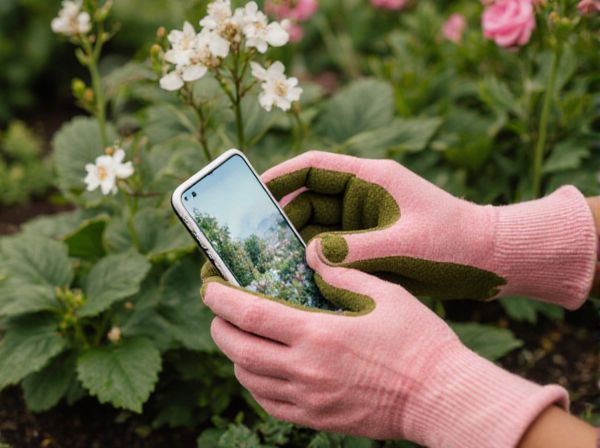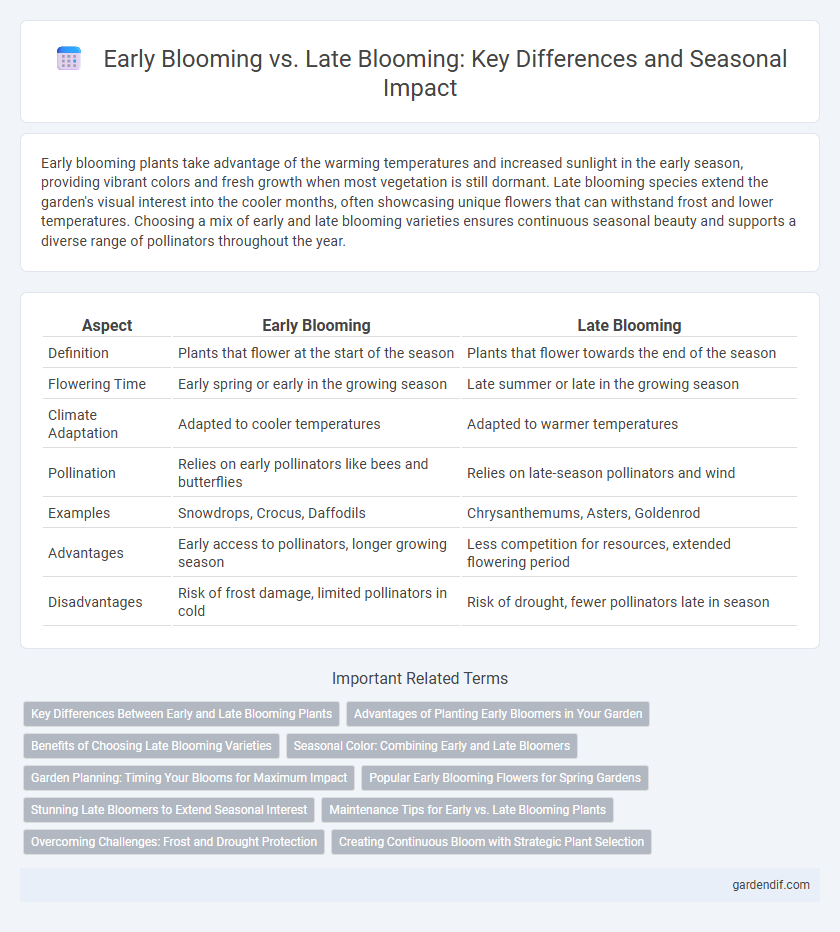
Early blooming vs Late blooming Illustration
Early blooming plants take advantage of the warming temperatures and increased sunlight in the early season, providing vibrant colors and fresh growth when most vegetation is still dormant. Late blooming species extend the garden's visual interest into the cooler months, often showcasing unique flowers that can withstand frost and lower temperatures. Choosing a mix of early and late blooming varieties ensures continuous seasonal beauty and supports a diverse range of pollinators throughout the year.
Table of Comparison
| Aspect | Early Blooming | Late Blooming |
|---|---|---|
| Definition | Plants that flower at the start of the season | Plants that flower towards the end of the season |
| Flowering Time | Early spring or early in the growing season | Late summer or late in the growing season |
| Climate Adaptation | Adapted to cooler temperatures | Adapted to warmer temperatures |
| Pollination | Relies on early pollinators like bees and butterflies | Relies on late-season pollinators and wind |
| Examples | Snowdrops, Crocus, Daffodils | Chrysanthemums, Asters, Goldenrod |
| Advantages | Early access to pollinators, longer growing season | Less competition for resources, extended flowering period |
| Disadvantages | Risk of frost damage, limited pollinators in cold | Risk of drought, fewer pollinators late in season |
Key Differences Between Early and Late Blooming Plants
Early blooming plants typically flower in cooler temperatures, taking advantage of early spring sunlight and reduced competition for pollinators. Late blooming plants flower in warmer conditions later in the season, often benefiting from extended daylight and increased availability of pollinators. Key differences include variations in growth cycles, temperature tolerance, and adaptation strategies to seasonal changes.
Advantages of Planting Early Bloomers in Your Garden
Planting early bloomers in your garden takes advantage of the extended growing season, providing vibrant color and fresh pollen sources for pollinators at the start of spring. Early bloomers such as crocuses, tulips, and daffodils can improve soil health by breaking dormancy and enhancing microbial activity ahead of warmer months. Establishing these plants early also reduces competition from weeds and maximizes the use of available sunlight before canopy closure.
Benefits of Choosing Late Blooming Varieties
Late blooming varieties offer extended growing seasons, allowing plants to avoid early spring frost damage and thrive in more stable temperatures. These varieties often produce higher yields and improved fruit quality by maturing during optimal weather conditions. Choosing late blooming plants enhances garden resilience and reduces the risk of crop loss from unpredictable early-season weather events.
Seasonal Color: Combining Early and Late Bloomers
Seasonal color is enhanced by combining early blooming plants such as crocuses and daffodils with late bloomers like asters and chrysanthemums, creating a continuous display of vibrant hues from spring through fall. Early bloomers provide fresh, bright blossoms after winter dormancy, while late bloomers extend garden interest into cooler months with rich, warm tones. Strategically coordinating these plants ensures dynamic seasonal transitions and prolonged floral appeal in landscapes.
Garden Planning: Timing Your Blooms for Maximum Impact
Early blooming plants like crocuses and tulips provide vibrant color at the start of spring, creating an immediate visual impact in garden design. Late blooming varieties such as asters and chrysanthemums extend the flowering season into autumn, ensuring continuous interest and appeal. Strategic garden planning involves selecting a mix of early and late bloomers to achieve a seamless progression of colors and textures throughout the growing season.
Popular Early Blooming Flowers for Spring Gardens
Popular early blooming flowers for spring gardens include crocuses, snowdrops, and daffodils, which thrive in cooler temperatures and signal the start of the growing season. These bulbs emerge from the ground even when snow is still melting, providing vibrant colors and essential nectar sources for early pollinators. Planting early bloomers enhances garden aesthetics and supports ecosystem health by attracting bees and butterflies before most other plants flower.
Stunning Late Bloomers to Extend Seasonal Interest
Stunning late bloomers like chrysanthemums, asters, and sedum extend garden interest well into the fall, providing vibrant colors when early bloomers fade. These resilient plants thrive in cooler temperatures and shorter daylight hours, ensuring continuous visual appeal as the season transitions. Incorporating late-blooming varieties enhances biodiversity and creates a dynamic, long-lasting seasonal display.
Maintenance Tips for Early vs. Late Blooming Plants
Early blooming plants require consistent moisture and protection from late frosts to sustain healthy growth, while late blooming varieties benefit from enhanced soil fertility and regular pruning to promote robust flowering. Tailoring fertilizer applications to the specific growth phases of early and late bloomers maximizes nutrient uptake and bloom quality. Monitoring for pests and diseases according to each plant's blooming cycle reduces stress and maintains vibrant seasonal displays.
Overcoming Challenges: Frost and Drought Protection
Early blooming plants often face significant risks from late frosts, necessitating protective measures such as frost cloths or wind barriers to shield delicate buds. Late blooming species, while avoiding frost damage, must endure the increased risk of drought during warmer, drier periods, requiring deep watering and mulching to maintain soil moisture. Effective frost and drought protection strategies are critical for maximizing growth and ensuring plant survival in variable seasonal conditions.
Creating Continuous Bloom with Strategic Plant Selection
Selecting a blend of early blooming bulbs such as crocus and snowdrops alongside late blooming perennials like asters and chrysanthemums ensures continuous floral display throughout the growing season. Strategic plant selection maximizes garden aesthetics by overlapping bloom times and filling gaps, supporting pollinators over extended periods. Utilizing diverse plant species adapted to local climate conditions enhances bloom longevity and garden resilience.
Early blooming vs Late blooming Infographic

 gardendif.com
gardendif.com